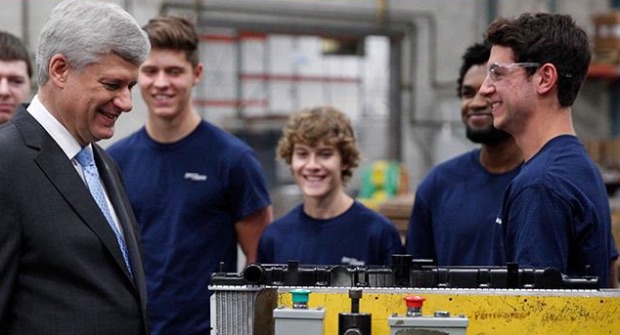Last week, as federal parties continued to court the youth vote, students at the University of Calgary got a strange surprise. Photos quickly surfaced online of a controversial Conservative pamphlet being handed out on campus: “Let the lefties run your campus. Help the Conservatives run the country,” boasted one side. The back featured photos of a family looking way too stock to be real, a bomb-laden fighter jet, and a grimy jail cell, with the caption: “Dropping taxes for families. Dropping bombs on ISIS. Dropping crooks in jail.”
With its cheap shot at unnamed campus leftists and its flippant remarks about crime and terrorism, it’s easy to see why some found the pamphlet upsetting. But the pamphlet is worrisome for another important reason as well. In a campaign that has seen all three major parties go to great lengths in order to win youth support, it’s an example of how some of the promotional material they aim at young voters still lack the substance and seriousness needed to be effective.
The approach behind the Conservative pamphlet, for example, is clear: Appeal to a generation that Tory strategists see as obsessed with Twitter, Snapchat, and Vine, the Conservatives felt the need to cut their message down to byte-sized form. This format, combined with the cringeworthy attempts to seem casual (When would Stephen Harper ever use a word like “lefties?”) is an ineffective way for the Conservatives to get their message across. In their platform, the Conservatives promise to double educational grants to low and middle-income students, but for some reason “dropping crooks in jail” seemed a more relevant slogan for a pamphlet aimed at students. The resulting pamphlet sounds less like a summary of the Conservative platform, and more like a George W. Bush attempt at a haiku. At least the last line has five syllables.
While the Conservative pamphlet is definitely the worst offender, the Liberals and the NDP also struggle to get their message across when marketing to young voters. Despite solid groundwork from local candidates, and engaging rhetoric from party leaders, some promotional material lack the substance needed to attract the youth vote. In order to reach young voters, both the Liberals and the NDP have set up dedicated youth websites. Yet these websites, which would be a great way for parties to present youth issues, are instead superficial and off-base.
On the Liberal youth website, the guiding philosophy seems to be that every bit of content aimed at youth needs its own social media tie-in. The site itself, called #GenerationTrudeau, features tabs such as #ReadyToVote, and numberless pleas to share every last detail on Facebook or Twitter. There’s even an endorsement for their Facebook and Twitter accounts within a larger endorsement for their Instagram page; however, #GenerationTrudeau does deserve some credit: After sifting through the sea of hashtags, one can find a clear and concise rundown of Liberal policy promises. Nonetheless, the implicit message that drives their site—that youth only care about something if it has a hashtag—is disappointing to see coming from the party with the youngest leader. Justin Trudeau and his fellow Liberal candidates have been doing a good job of engaging young voters by addressing issues they care about, such as putting a price on carbon emissions, managing student debt, and legalizing marijuana—and these should be the focus of their online efforts as well.
The NDP’s youth website, Young new democrats, takes a different approach. The homepage features a large picture of a backpack, captioned “What’s Stephen Harper putting in your backpack?” It’s followed by a brief paragraph criticizing the incumbent prime minister, then ends: “Keep Stephen Harper’s hands off your backpack and your future.” The backpack metaphor is a lame cliché, and the heavy-handedness of it almost makes it seem as if the NDP really believes young voters are incapable of grasping abstract concepts like ‘the future’ without repeated reference to backpacks. Yet unlike #GenerationTrudeau, there is no NDP policy proposals to be found anywhere on the site. How they hope to woo young voters with a site that offers no real content remains a mystery.
Perhaps what’s most surprising about this lacklustre promotional material is how much it clashes with the parties’ other attempts to attract youth voters. Party leaders and candidates alike are willing to discuss youth issues seriously and in depth; at last week’s CKUT debate on campus, candidates held a substantive and focused discussion on how their parties’ policies would impact young Canadians. Targeted advertising campaigns, like pamphlets and websites can be a great way to get young people involved, but only if parties stop focusing on distracting hashtags and dumbed-down slogans instead of presenting policy content that will engage and excite youth.









